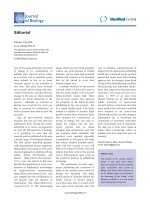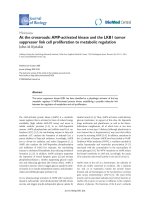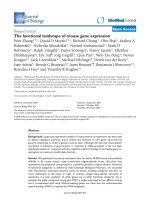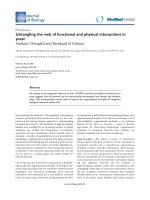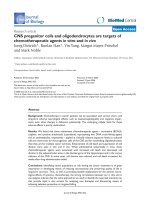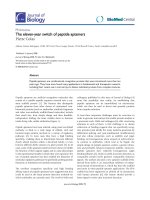Báo cáo sinh học : " Louis Du Pasquier" pdf
Bạn đang xem bản rút gọn của tài liệu. Xem và tải ngay bản đầy đủ của tài liệu tại đây (253.47 KB, 5 trang )
Minireview
FFiisshh ‘‘nn’’ TTRRIIMMss
Louis Du Pasquier
Address: University of Basel, Institute of Zoology and Evolutionary Biology, Vesalgasse 1, CH-4051 Basel, Switzerland.
Email:
Multigene families are common in metazoa. They result from
genomic duplications and contain a variety of genes, such as
those encoding the immunoglobulin superfamily, cadherins,
leucine-rich repeats, scavenger receptors, actins, tubulins,
keratins, collagens, heat shock proteins and rhodopsins. The
largest receptor families, which can contain tens to hundreds
of members, comprise mostly either olfactory receptors of the
rhodopsin family or immunoreceptors, such as cysteine-rich
scavenger receptors (SRCRs) and Toll-like receptors (TLRs) in
echinoderms and the nucleotide-binding and oligomeriza-
tion domain leucine-rich repeat receptors (also known as
NOD-like receptors or NLRs) in teleosts, as well as other
immunoglobulin superfamily members in teleosts, amphi-
bians, birds and mammals [1].
In such families the immunologist sees a potential source of
useful diversity for innate immune recognition and imme-
diately thinks in terms of its adaptive value. The evolu-
tionary biologist reminds us that not all diversity is adaptive
and asks for direct evidence of involvement in immunity. At
this point the cell biologist confronts the difficult issue of
how the expression of large sets of genes is controlled.
Tripartite-motif (TRIM) intracellular receptors have been
implicated in control of proliferation, differentiation,
development, oncogenesis, apoptosis and antiviral activity
in various mammalian species. They comprise a RING
finger with E3 ubiquitin ligase activity, a B-box (a type of
zinc-finger domain) and a coiled-coil domain mediating
oligomerization. Some TRIMs are coupled to the B30.2
module - a fusion of the Pry and Spry domains [2] - which
mediates diverse functions in at least six families of human
receptor by binding to targets through an interface resemb-
ling that of an antibody [3]. The mode of action of the
B30.2 domain is mostly unknown, but it may confer anti-
viral activity on TRIM [4], which is why these molecules are
of particular interest. In humans there are 75 TRIMs [5]. All
metazoan TRIMs fall into 11 classes [4], all of which
contain the above mentioned ring box, one or two B boxes,
and a coiled-coil region. The classes are defined according
to the absence (class V) or the presence of one to three
extra domains.
For the TRIMs discussed in this minireview - that is,
those that have been duplicated - these extra domains
are: C-terminal subgroup one signature (classes I, II and
III), fibronectin type III (classes I and III), B30.2 (classes
I and IV), plant homeo- and bromodomains (class VI),
and filamin and NHL (NCL1, HT2A, LIN41 repeat)
(class VII).
AAbbssttrraacctt
A novel diversified multigene family of tripartite-motif (TRIM) intracellular receptors with
putative antiviral activity has been identified in teleost fish and published in
BMC Biology
. The
history of these receptors involves ancient linkage to paralogs of the major histocompatibility
complex, and the family has invertebrate precursors.
Journal of Biology
2009,
88::
50
Published: 29 May 2009
Journal of Biology
2009,
88::
50 (doi:10.1186/jbiol150)
The electronic version of this article is the complete one and can be
found online at />© 2009 BioMed Central Ltd
A recent paper by van der Aa et al. [6] in BMC Biology has
now identified a novel large multigene family of TRIM
proteins in teleosts, the most abundant infraclass of bony
fish, with over 25,000 species. The TRIM proteins are en-
coded by the fintrim (ftr) and the bloodthirsty-related (btr)
genes and include a TRIM domain coupled to a B30.2
module. Expression of the genes can be induced by
experimental viral infection (by intravenous injection of the
viral suspension) in teleost cells and may thus contribute to
antiviral defense in these fish. The fish TRIM family is an
interesting model because, first, it is amplified uniquely in
fish (see [7] for a recent discussion of duplications in the
teleost genome) and thus provides a new model for
studying the origin, raison d’être and evolution of large
multigene families putatively involved in vertebrate im-
munity; and second, because comparative data may help to
determine which segments of the receptors are essential
(rather than accessory) to antiviral activity, in particular
with respect to the B30.2 domain.
FFiisshh
ffttrr
ddiivveerrssiittyy aanndd cchhrroommoossoommee llooccaattiioonn
The report by van der Aa et al. [6] describes two subsets of
the 240 zebrafish TRIMs, which the authors named the
fintrim (ftr) and the bloodthirsty-related (btr) genes. The 84 ftr
genes and 33 btr genes encode class IV TRIMs (RING finger-
B-box-coiled-coil-B30.2 proteins) [4]. The ftr genes stem
from an unknown ancestor and make up a teleost-specific
family encoding proteins induced by viral infection. Ftrs
evolved through positive selection of residues in the B30.2
domain homologous to those involved in viral recognition
of the mammalian anti-retroviral protein TRIM5α; they are
therefore likely to form a family of immune receptors since,
in a changing viral environment, diversity of recognition of
determinants is a selective advantage for an immune system
[6]. The family illustrates a recurrent observation: during
evolution, families of genes with non-immune functions in
other organisms may become diversified in some species to
fulfill functions in immune recognition and defense.
Another example of such evolution is shown by members of
the immunoglobulin superfamily in invertebrates and
vertebrates [8]. In the case of Ftr proteins, the pressure to
diversify must have been intense because different species of
phylogenetically distant teleosts have generated ftr families
through different mechanisms: tandem duplications in
zebrafish and retrotranspositions in medaka. This conver-
gence suggests again that Ftr diversity has adaptive value.
One possibility is that this great diversity compensates for
deficiencies in adaptive immunity to viruses.
The other subset of zebrafish TRIMs, the Btrs, stems from an
ortholog of mammalian Trim-39. Members of this subset
are not documented to have any involvement in immunity,
but the fact that the genes are highly amplified whereas
trim-39 is not raises some interesting questions, and
studying the origin and diversification of both subsets may
prove useful.
Can any possible evolutionary scheme be derived from the
position of ftr and btr genes on the chromosomes? Their
presence on 16 of the 25 chromosomes suggests they are
very mobile and can diversify independently of each other.
However, their multiplicity may partly be due to the fact
that, in addition to the two rounds of polyploidization
common to gnathostomes, teleosts have had an extra
round, which resulted in eight potential paralogous sets of
chromosomes instead of the four found in other
vertebrates. So do the numerous ftr and btr clusters match as
many paralogous regions? Indeed, it seems that they are all
located on chromosomes that also contain major histo-
compatibility complex (MHC) genes or their paralogs
(Figure 1). This pattern fits with the hypothesis that, during
the generation of the zebrafish genome, a region containing
MHC and TRIM-B30.2 genes duplicated several times, in
agreement with the above hypothesis of several genome
duplications. If validated by statistical tests, this observation
would suggest two things: first, that the ftr genes, which are
present in a smaller number of clusters than the other
TRIM-B30.2 genes, diversified later and specifically in
teleosts from one of those early MHC-linked genes; and
second, that the MHC-TRIM-B30.2 linkage is ancient and
preceded the two rounds of genome duplication common
to gnathostomes. Therefore, it is likely that relatives of
TRIM-B30.2 existed in invertebrates.
The linkage to MHC and its three paralogous regions [9] is
not only ancient, it is also conserved, as several genes
encoding proteins with TRIM and B30.2 domains and with
antiviral activity are also MHC-linked in various vertebrate
lineages, such as birds and mammals [10-12] (Figure 2a),
and some are also moderately amplified (such as TRIM5
genes, with five contiguous members) in a way that is remi-
niscent of the ftr amplification [13]. Was the immunological
antiviral function of such receptors a reason to be selected
for co-segregation with the region of the MHC containing
genes encoding proteins that are associated with inflam-
matory responses, such as tumor necrosis factor and
components of the antigen-presentation machinery? It may
have contributed to the creation of a massive assembly of
immunity-related genes, which would have had the
advantage of being inheritable as a single unit. This linkage
may no longer have any selective value in some species,
given that it is not apparent in the stickleback, a species of
teleosts that has diverged more recently than the zebrafish.
In zebrafish, it may simply be a ‘fossil’ of an ancient, once
useful architecture.
50.2
Journal of Biology
2009, Volume 8, Article 50 Du Pasquier />Journal of Biology
2009,
88::
50
TThhee BB3300 22 ddoommaaiinn:: oorriiggiinn aanndd mmoobbiilliittyy
The antiviral properties of TRIM proteins seem to be due
mainly to the RING finger-B-box region (in TRIM25) and
the B30.2 module (in TRIM5). These two regions work in
different ways: through the ubiquitination pathway for the
RING finger-B-box region, and by interference with virus
decapsidation and replication for the B30.2 module [4].
Very little is known about B30.2 evolution beyond
vertebrates. Briefly, the hypothetical evolutionary history of
B30.2 is often presented in phases [3-5]: an ancient Spry
domain inherited from an ancestral form later became
associated with a Pry domain to give the final B30.2
configuration seen only in vertebrates. My analysis of
sequences from various invertebrates (Figure 2) shows
clearly the presence of a B30.2 domain associated with
TRIM-like molecules. In cnidarians, there seems to be two
classes of TRIM: class I, with fibronectin type III and B30.2
domains; and class V, without a B30.2 domain. However, in
echinoderms, such as the sea urchin, the B30.2 domain is
rare. Among the chordates, many classes and many
members exist in amphioxus (Cephalochordata), whereas
/>Journal of Biology
2009, Volume 8, Article 50 Du Pasquier 50.3
Journal of Biology
2009,
88::
50
FFiigguurree 11
Position of MHC and TRIM-B30.2 genes in the zebrafish genome. Green asterisks denote chromosomes with clusters of
btr
and
ftr
genes, and the
number of these genes on the respective chromosome is shown below in green. MHC and MHC-paralogous genes are in magenta. Class II MHC
genes have not been indicated; these are on chromosome 8 and not associated with any B30.2 TRIM. In addition, chromosome 16, which is rich in
MHC-paralogous genes, has a few Trim-39-like genes not mentioned in [6]. In teleosts many rearrangements have caused the MHC elements that
would normally be closely linked to be scattered; in this context, the loose linkage of TRIM genes to MHC genes is not unexpected. Modified from
Figure 2 of [6].
0
1x10
6
2x10
6
3x10
6
4x10
6
5x10
6
6x10
6
7x10
6
01234 5678 910
Chromosome
Base pairs
btr01
ftr01
ftr66
ftr02-15
ftr17-27
ftr67-68
ftr28-39
ftr82-83
ftr84
trim25
btr03-07
btr08-09
btr10
btr11
ftr52
ftr53
ftr54
ftr69-70
btr14-17
ftr71-77
ftr55
ftr56
btr28-29
btr30
ftr78-79
ftr57-59
btr31-32
ftr60-6
2
btr33
ftr63
trim16
tapbp
classi
lmp7
tap
lmp2
tap2
ring3
col11a
rxrb
bat1
tnfa
lmp7-l
rxr-l
4mhc1ze
btn1
btn2
hsp70
bat1
glpr1
ring3-l
notch1
pbx3
c4
glpr1-l
lrfn2
*
41
*
12
*
11
*
11
*
15
notch2
6btr
genes
ring3-l
pbx2,
rgl2
flot1
apobec
col11a
col11a
col11a
*
4
mhc1ze
Ftr40-42
ftr44-50
ftr43
btr12-13
ftr16
btr02
btr18-27
*
3
*
6
ftr51
11 12 13 14 15 16 17 18 19 20 21 22 23 24 25
the sea squirt Ciona (Urochordata) has only ten TRIMs [5]
and only one has so far been found to contain a B30.2
domain. As yet, no association of a B30.2 domain with an
extracellular immunoglobulin superfamily domain has
been found in invertebrates. The shuffling of the B30.2 exon
seems specific to vertebrate butyrophilins (a family of
receptors named from a milk protein but that contains
several immunologically relevant molecules). This asso-
ciation of a B30.2 domain with a MHC-linked immuno-
globulin superfamily member must be old since it is shared
between mammals [10-11] and the zebrafish. Indeed,
chromosome 3 of Danio (zebrafish) contains two
50.4
Journal of Biology
2009, Volume 8, Article 50 Du Pasquier />Journal of Biology
2009,
88::
50
FFiigguurree 22
Comparison of sequences and chromosomal positions of TRIM and MHC genes between species.
((aa))
Human MHC-paralogous regions. The 1pq,
6p21 and 9q segments are the classical MHC-paralogous regions [8]. For simplicity only selected markers are shown, particularly MHC markers
shared with the fish markers shown in Figure 1. For the purposes of this article I identified a set of genes on human chromosome 11p so far not
considered as a MHC-paralogous region but that indeed seem to correspond to a group of MHC-paralogous genes that are missing from the group
present on chromosome 19p13. Asterisks indicate genes for which paralogs have also been identified on chromosome 12p13, which is also known to
contain some MHC-paralogous genes. Two chromosomes also have ATP5L homologs (green) linked to TRIM genes, as also found for three fish
species in [6]. TRIMs in blue are those with antiviral activity. Lines indicate paralogous loci.
((bb))
Alignment of B30.2 (Pry-Spry) domains across
metazoa. Invertebrates are represented by the following sequences: a diploblastic cnidarian (sea anemone,
Nematostella
, XM_001632290), a
protostome insect (
Drosophila
, NP_723600.2), a chelicerate (tick,
Ixodes
, EEC02812), a deuterostome echinoderm (sea urchin,
Strongylocentrotus
,
XR_026371), a tunicate (sea squirt,
Ciona
, XM_002126032) and a cephalochordate (amphioxus,
Branchiostoma
, XM_002222150). Vertebrates are
represented by: a teleost fish TRIM-B30.2 (zebrafish,
Danio
, XM_001332270), human CD277 (
Homo
, NP_001138480, given as an example of B30.2
associated with a molecule other than TRIMs), and rat Trim9 (
Rattus
, NP_569104, of which several invertebrate TRIMs are close homologs). Red,
residues conserved in more than 50% of the sequences; blue, regions considered as signatures of the B30.2 domain [2]. Strand prediction (shown
above the sequences) is taken from the Phyre server [17].
((cc))
Schematic representations using SMART [18] of TRIM-related proteins from
Nematostella
(close to class I of [5]) and
Branchiostoma
(close to class IV of [6]). The Pry domain is not always suggested by the graphic SMART
program, as for
Nematostella
here, but it is visible in the alignment. Data obtained from the ENSEMBL [19], UCSC [20] and Vectorbase [21] servers.
Nematostella
XM_001632290
XP_002229222
(a)
Branchiostoma
(b)
(c)
6p21 Homo
TRIM38
BTN3A2
BTN2A2
BTN3A3
TRIM27
TRIM31
TRIM40
TRIM10
TRIM15
TRIM26
TRIM39
BAT1
NOTCH4
TAPBP
ZBTB22
DAXX
CEGF3
ZNF76
DEF6
TULP1
GLPR1
LRFN2
APOBEC2
6q Homo
ATP5L
11p15-p13 Homo
TUB (TULP-L)
TRIM21
TRIM68
TRIM6
TRIM34
TRIMP1
TRIM5
TRIM22
TRIM3
LMO1*(LMO312p)
TRIM66
ZNF143 (ZN76-like)
CEGP1 (Cegf3-like)
SWAP70 (DEF6 like)
AMPD3
MRV1* LRMP 12p
Tapasin-like*
TRIM44
11q14 Homo
TRIM51
TRIM48
TRIM49
TRIM64
TRIM-(LOC399940)
ATP5L5
1p11 q25 Homo
TRIM62
TRIM63
Ampd2
TRIM33
Ampd1
TRIM45
Notch 2
PBX1
TRIM46
TRIM11
TRIM17
TRIM58
9q Homo
TRIM14
TRIM32
PBX
NOTCH1
β1 β2 β3 β4 β5 β6
Homo CD277
PA
DVH
LDP N
TAH
PW
L
ALS
EDRRQ
V
WDGGQRRDLVDTPER FDTAPC
VLGSK
G
FTT
GR
HYWEVDVGDKPAW DLGVAR
QSVDRKGV VTLSPE
Rattus Trim9
V
A
W
F
AF
DP GSAHSDIIFSNDN
LTVTCSSY DDRVVLG
KT
G
FSK
GV
HYWELTIDRYDNHPDP AFGVARIDVMKD MM
LG
KD
Danio FinTRIM18 FQQLSLDP N
TAH
KH
L
RL
SDG
N
RVATNTDKVQRYPDHPDR FDNFSGLVCRESVS-
G
RCYWEVEWRPNEGDYGM GVALAYKSIKRKAQRYISGF
GCN
Strongylocentrotus V
A
WFHPDP RTAHKDIIFTNENM
T
LTCNNQ DDRI
VLGNVGFSKGVHYWEVTIDRYDNHPDP AFGVARLDTSKD TMLGKD
Branchiostoma GIKF
KF
DP
N
TAH
RS
L
KFS
NKSTV
V
SRDVEGAKHRHVPKRPERFVDGPYRAGNPL
VLGDV
AITSG
KHYWEISVNEST IYIIGIAYRSTRRD ERLGDN
Ciona GIPFQFDA HSMH
KK
LRLANHSY
TV
SREESGKKSKDFLGNSRDS TVCGVTGNVAIDSGRHYWEVVICQSTSFTMGV-CYAQAARYD WNGKN
Drosophila VA
W
F
TFDP
VLSGGA
GSGL
IFSKN
NA
TV
SVEGW EHRVA
LGSV
G
FSR
G
VHY
WEFTIDNYTADTDP AFGVAR
I
DVARN KM
LGK
D
Ixodes V
A
WFALDP GSCHPDVVLS
DE
NVT
ARCESY EHRV
VLGSLGFSRGVHYWEATVDRCDNDADV VLGVARGDVAKD VMLGKD
Nematostella
GLY
F
Q
LDP S
TANHEL
EM
SPDDC
TV
ALKSP MYTFILGN
VKLSSGR
HYWRVHVDEFSSPNQLSIIGVGI
ARG-IIDD
PI
LGE
D
* *
[ PRY ][
β7
β8 β9 β10 β11 β12 β1
3
Homo CD277
D
GF
WSVCLRGG SEYRACAGEAELLALPRKPRVIGVFLDFEDGTVSFYDAGAQSHIYSFTD YQFSEAMFPFLNPDISDSSANQSPLT
Rattus Trim9 DKAW
AMYVDNN RS
WFMHNNSHTNRTEGGITKGATIGVLLDLNRKTLTFFVNNEQQGPIAF
EN VEG LFFPA
VSLN-R
NV
QV
TL
HTG
LPV
P-
DFYSSRASIA
Danio FinTRIM18 D
QS
WSLFCSNS RYTFRHNGQQKKLYVFPIS-SRIGVYVDPKAGILSFFSVSDTKMSLIHRVQTTFT EPLYPGFWVYKSKVNLCHLKTFHPDCDNFDD
Strongylocentrotus
DKS
W
SMYIDSN RSWFIHNNAHSDRCEGGIGVGSVVGVLLDLDKHVLCFYVNDKAQGPVAF
KD MKG VFF
PAF
SLN-H
NVQVTVHPG
LEI
PTD
FD
Branchiostoma
ATS
WILDRTGN DYETRHAGKPHKLKLDPHP-VR
IG
IL
LDYEAGRV
SF
FDAETRRKLYT
FKDHFAN PVCPAFGVW DGE
LT
L
HTG
LKAIRDLENQPSFSR
Ciona
SMS
W
CFCRTND D
WFARHDSKDSPIIMPSPEPKKIGVLLDCDLGTVAFFDGASGRLLYTF
CVSGFER PVR
PCFTVG NKSLTINTG
VTV
P-D
HLHPIG
Drosophila
EKSFAMYIDRQ RS
WF
QHNSIHERRVEGGITTGST
IGVLLDLERHTLSFLVNEMPQGSVAF
RD LYG VFY
PAVSIN-RGVTLTMHTAMDAPKMDY
Ixodes D
KG
WSMYIDHQ RSWFLHADRHEHRVDGGVERGAVLGVLLDLERRQLSFYVNDERQGPCVVLGPPIQGPGAALFPAFSLN-RNVQLTVHTALDPPASSS
Nematostella SHSYAVQINEHPTTTCINTKNRIQIKRSSAEMTNSNVGVLLNLDDHLLNIYFN GKSVPNGPTFHGITQAFYPALSLYGM
NVKLTVHTGEAFDT
*
SPRY
]
butyrophilin homologs - btn1, which encodes a protein
containing the B30.2 domain, and btn2, which does not -
and several MHC markers (Figure 1). The existence of TRIM-
B30.2 but the absence of butyrophilin in invertebrates
suggests that the B30.2 domain was shuffled from a TRIM
into one of the nearby MHC-linked immunoglobulin super-
family members (resembling, for instance, zebrafish btn2).
In mammals, the B30.2 domain can be associated with
surface, cytoplasmic and nuclear receptors and even with
some soluble proteins, such as toxins [2,3]. It remains a
mystery why the B30.2 domain is associated with or has
colonized so many different genes in some organisms but
remains rare among others. However, ‘rare’ is not the term
one would use for the B30.2 domain in teleosts. Following
exon shuffling, B30.2 domains similar to those of Ftr
proteins expanded tremendously into another large family
of zebrafish intracellular receptors, the NOD-like receptors
(NLRs) [14,15], which can function as immunoreceptors
[16]. These receptors resemble plant disease resistance
proteins and are involved in responses to pathogens. To-
gether, the findings that TRIM-B30.2 is present in inverte-
brates but that B30.2 domains are absent from the NLRs of
vertebrates except teleosts suggests that TRIM-B30.2 is older
than NLR and that the exon shuffling caused a B30.2
domain to move from a TRIM-B30.2 gene to an NLR gene
rather than in the opposite direction.
The existence of hundreds of similar B30.2 domains asso-
ciated with different intracellular immunoreceptors compli-
cates the analysis of their expression, especially when these
receptors are likely to be expressed in the same tissue and
sometimes even in the same cells. How are the different
receptors compartmentalized and how do they avoid compe-
tition? What is the specific role of the B30.2 domains in the
various receptors? Fish that diversified massively the B30.2
domains into two categories of receptors, the TRIMs and
NLRs, probably under different selection pressures, offer a
good model for experiments addressing these questions.
Van der Aa et al. [6] have opened Pandora’s box, and their
work suggests future directions for studies of the
phylogenies, linkage and functions of TRIM proteins and
their relationships with other immune-system components.
Their work calls for more experiments with the teleost
model: a more thorough analysis of all TRIM sequences in
fish might reveal new trends in the evolution of the family
and could enable investigation of the relationships with the
related TRIMs without B30.2 or RING-finger-B-box
moieties. Tissue localization, regulation of expression and
binding specificity must also be determined. This will be
difficult, but what is revealed is likely to be fascinating for
any biologist. Finally, many unanswered questions about
antiviral activity could profit from B30.2 comparative
models, among which invertebrates may offer natural
variations on the theme of TRIM-B30.2 receptors.
Comparative TRIMinologists have many happy days
ahead.
RReeffeerreenncceess
1. Flajnik MF, Du Pasquier L:
EEvvoolluuttiioonn ooff tthhee iimmmmuunnee ssyysstteemm
In
Fun-
damental Immunology
. 6th edition. Edited by Paul WE. Philadel-
phia: Wolters Kluwer, Lippincott Williams &Wilkins; 2008:56-124.
2. Henry J, Ribouchon MT, Offer C, Pontarotti P:
BB3300 22 lliikkee ddoommaaiinn
pprrootteeiinnss:: aa ggrroowwiinngg ffaammiillyy
Biochem Biophys Res Commun
1997,
223355::
162-165.
3. Rhodes DA, de Bono B, Trowsdale J:
RReellaattiioonnsshhiipp bbeettwweeeenn SSPPRRYY
aanndd BB3300 22 pprrootteeiinn ddoommaaiinnss EEvvoolluuttiioonn ooff aa ccoommppoonneenntt ooff iimmmmuunnee
ddeeffe
ennccee??
Immunology
2005,
111166::
411-417.
4. Ozato K, Shin DM, Chang TH, Morse HC 3rd:
TTRRIIMM ffaammiillyy pprroo
tteeiinnss aanndd tthheeiirr eemmeerrggiinngg rroolleess iinn iinnnnaattee iimmmmuunniittyy
Nat Rev
Immunol
2008,
88::
849-860.
5. Sardiello M, Cairo S, Fontanella B, Ballabio A, Meroni G:
GGeennoommiicc
aannaallyyssiiss ooff tthhee TTRRIIMM ffaammiillyy rreevveeaallss ttwwoo ggrroouuppss ooff ggeenneess wwiitthh ddiiss
ttiinncctt eevvoolluuttiioonnaarryy p
prrooppeerrttiieess
BMC Evol Biol
2008,
88::
225.
6. van der Aa LM, Levraud JP, Yahmi M, Lauret E, Briolat V, Her-
bomel P, Benmansour A, Poudinot P:
AA llaarrggee nneeww ssuubbsseett ooff TTRRIIMM
ggeenneess hhiigghhllyy ddiivveerrssiiffiieedd bbyy dduupplliiccaattiioonn aanndd ppoossiittiivvee sseelleeccttiioonn iinn
t
teelleeoosstt ffiisshh
BMC Biol
2009,
77::
7.
7.
BBrraaaasscchh II,, SSaallzzbbuurrggeerr WW:: IInn oovvoo oommnniiaa:: ddiivveerrssiiffiiccaattiioonn bbyy dduupplliiccaa
ttiioonn iinn ffiisshh aanndd ootthheerr vveerrtteebbrraatteess
J Biol
2009,
88::
25.
8. Zucchetti I, De Santis R, Grusea S, Pontarotti P, Du Pasquier L:
OOrriiggiinn aanndd eevvoolluuttiioonn ooff tthhee vveerrtteebbrraattee lleeuukkooccyyttee rreecceeppttoorrss:: tthhee
lleessssoonn ffrroomm ttuunniiccaatteess
Immunogenetics
2009, doi:10.1007/s00251-
009-0373-z.
9. Flajnik MF, Kasahara M:
CCoommppaarraattiivvee ggeennoommiiccss ooff tthhee MMHHCC::
gglliimmppsseess iinnttoo tthhee eevvoolluuttiioonn ooff tthhee aaddaappttiivvee iimmmmuunnee ssyysstteemm
Immu-
nity
2001,
1155::
351-362.
10. Abi Rached L, McDermott MF, Pontarotti P:
TThhee MMHHCC bbiigg bbaanngg
Immunol Rev
1999,
116677::
33-44.
11. Meyer M, Gaudieri S, Rhodes DA, Trowsdale J:
CClluusstteerr ooff TTRRIIMM
ggeenneess iinn tthhee hhuummaann MMHHCC ccllaassss II rreeggiioonn sshhaarriinngg tthhee BB3300 22 ddoommaaiinn
Tissue Antigens
2003,
6611::
63-71.
12. Ruby T, Bed’Hom B, Wittzell H, Morin V, Oudin A, Zoorob R:
CChhaarraacctteerriissaattiioonn ooff aa cclluusstteerr ooff TTRRIIMM BB3300 22 ggeenneess iinn tthhee cchhiicckkeenn
MMHHCC BB llooccuuss
Immunogenetics
2005,
5577::
116-128.
13. Sawyer SL, Emerman M, Malik HS:
DDiissccoorrddaanntt eevvoolluuttiioonn ooff tthhee
aaddjjaacceenntt aannttiirreettrroovviirraall ggeenneess TTRRIIMM2222 aanndd TTRRIIMM55 iinn mmaammmmaallss
PLoS Pathog
2007,
33::
e197.
14. Stein C, Caccamo M, Laird G, Leptin M:
CCoonnsseerrvvaattiioonn aanndd ddiivveerr
ggeennccee ooff ggeennee ffaammiilliieess eennccooddiinngg ccoommppoonneennttss ooff iinnnnaattee iimmmmuunnee
rreessppoonnssee s
syysstteemmss iinn zzeebbrraaffiisshh
Genome Biol
2007,
1133::
R251.
15. Laing KJ, Purcell MK, Winton JR, Hansen JD:
AA ggeennoommiicc vviieeww ooff
tthhee NNOODD lliikkee rreecceeppttoorr ffaammiillyy iinn tteelleeoosstt ffiisshh:: iiddeennttiiffiiccaattiioonn ooff aa
nnoovveell NNLLR
R ssuubbffaammiillyy iinn zzeebbrraaffiisshh
BMC Evol Biol
2008,
88::
42.
16. Sirard JC, Vignal C, Dessein R, Chamaillard M:
NNoodd lliikkee rreecceeppttoorrss::
ccyyttoossoolliicc wwaattcchhddooggss ffoorr iimmmmuunniittyy aaggaaiinnsstt ppaatthhooggeennss
PLoS Pathog
2007,
33::
e152.
17.
PPhhyyrree
[ />18.
SSMMAARRTT
[ />19.
EENNSSEEMMBBLL
[ />20.
UUCCSSCC
[ />21.
VVeeccttoorrbbaassee
[ /> />Journal of Biology
2009, Volume 8, Article 50 Du Pasquier 50.5
Journal of Biology
2009,
88::
50
